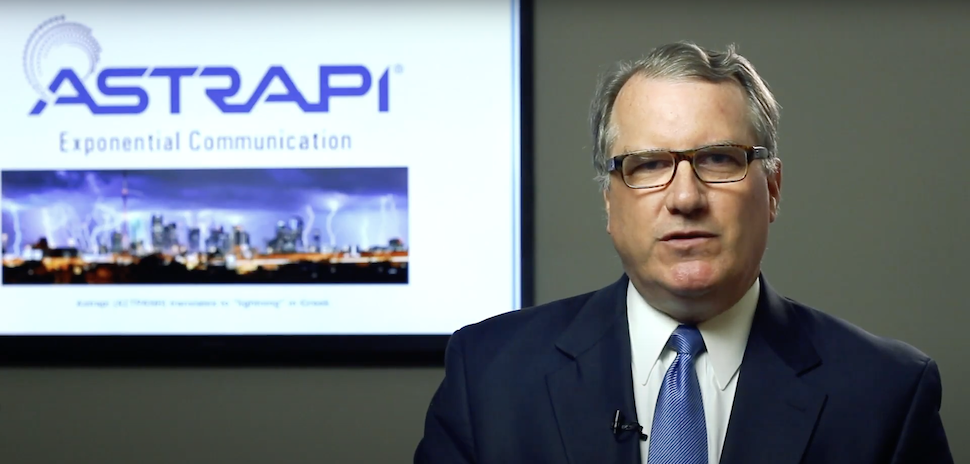The current flap about 5G deployment near U.S. airports may sound complex. But it’s about the possibility of something simple: radio interference. Beyond the 5G issue, the radio spectrum overall is increasingly constrained by congested bandwidth. That’s critically important for warfighters flying U.S. Air Force jets and for the U.S. Space Force, which needs to communicate with satellites through secure signal transmissions. Now Astrapi—a company based in North Dallas—is working to help both with an innovative advance: spiral modulation.
Astrapi has been awarded its second Phase II SBIR contract from the U.S. Air Force’s AFWERX program. The goal: Enable warfighters to get more information through a radio channel while using less signal power. That will address issues with both congested and contested communication channels.
Astrapi plans to achieve that by implementing its advanced communication capability—spiral-based signal modulation—in a Software Defined Radio (SDR) prototype. The company, which was founded in 2009, calls spiral modulation “a revolutionary method of communication” and “a game-changing force in communications technology.”
“The problem we address is congested bandwidth,” David Shaw, Astrapi’s co-founder and chief commercialization officer, told Dallas Innovates. “When you get an ‘unstable connection’ message on a Zoom call, a rapidly degrading battery on a smart device, or are unable to get photo or email out at a sporting event or concert, you’re suffering from constrained bandwidth.”
“We lived that during lockdowns with increased demand for videoconferencing, remote learning, telemedicine, advanced gaming, and high-definition entertainment,” Shaw said. He added that Astrapi’s core tech is “very much a dual-use technology” for both defense and commercial markets: “We address communication channels that are capacity- and signal power-constrained and subject to increasing amounts of interference.”

[Photo: TebNad/iStock]
Nearly $1.5M in U.S.A.F. and Space Force-funded contracts in past four months
This is Astrapi’s second Phase II SBIR contract awarded in the past four months, totaling nearly $1.5 million. It complements another project funded with support from the U.S. Space Force, focused on Symbol Waveform Hopping (SWH), a unique way to secure signal transmission. Astrapi is currently working with an SDR hardware partner—San Diego-based Space Micro—to demonstrate spiral modulation in a Ka-band radio that’s radiation hardened and suitable for Low Earth Orbit (LEO) deployment.
The miniaturized radio will have on-orbit signal processing capabilities and will also be suitable for medium and geosynchronous orbit deployments.
“The radio we’ve selected enables us to move into other frequency bands or orbits,” Shaw said. “A prototype enables us to demonstrate capability for many other uses such as drones, lunar, deep space, terrestrial wireless, sensors” and more.
‘Whoever controls the spectrum will control the battlespace’
Dr. Jerrold Prothero, founder and CEO of Astrapi, says “It’s becoming increasingly clear that whoever controls the spectrum will control the battlespace. Astrapi’s capabilities help to achieve that critical advantage.”
“We’re quite excited to advance this application of spiral modulation toward deployment,” Prothero added in a statement. “We have a strong, accomplished teaming partner in Space Micro. And we address a significant challenge—spectral efficiency.”

David Shaw, co-founder and chief commercialization officer of Astrapi. [Video still: Astrapi]
A breakthrough like elevators instead of stairs?
Explaining spiral modulation can get pretty technical. But Shaw makes it clearer by comparing it to something familiar: an elevator.
“In the not-too-distant past, one could only build a six-story building in Manhattan,” he told us. “No one wanted to walk up seven flights of stairs. Then Otis invented the elevator. One could now go up 100 floors or higher using the same tract of land. The elevator provided a much higher utility of the fixed assets—land.”
Shaw says Astrapi is doing the same thing with a different fixed asset—the radio spectrum.
“Existing approaches construct signals using sinusoids with constant amplitude,” he said. “You’ve probably seen a diagram of an AM/FM signal diagram. It’s a single wavy line with a peak/valley [for] amplitude value over symbol time. The general assumption is that spectrum is stationary.
“Uniquely, we use polynomials with continuously varying amplitude with non-stationary spectrum. This allows us to generate spirals. That’s never been done before. We are defining an entirely new field. So, it’s a big deal technically,” Shaw said.
The mathematics behind it all
Crave a more technical explanation? Prothero, the company’s founder and CEO, used Euler’s formula—the foundational mathematics for telecommunications—to open a path to dramatically higher spectral efficiency across a wide range of radio communications.
Here’s more on the mathematics behind it all, from Astrapi:
“Based on a new generalization of Euler’s formula, the foundational mathematics for the telecommunications industry, Astrapi has the ability to engineer signals as the sum of complex spirals. This unleashes, for the first time, the ability to fully exploit the capabilities of a continuously non-stationary spectrum.”
“Classical channel capacity theory contains, in the proof of the sampling theorem, an implicit assumption that the spectrum is at least approximately stationary. By violating this assumption, spiral modulation creates the opportunity to bypass the Shannon-Hartley law, the previous upper limit for spectral efficiency.”
That’s essentially how Astrapi is able to improve the trade-off between the four fundamental parameters in telecommunications: bandwidth, signal power, data throughput, and error rate. The resulting efficiency translates into higher spectral performance—with more bits available at a lower cost.
Astrapi has been awarded 15 U.S. patents, including one for Symbol Waveform Hopping, with more pending and with corresponding international patent coverage.
Read Next
Aces of Space
$699K NSF Grant, Partnerships Will Help Astrapi Soar into Next Phase
Contest Win Helps Astrapi Gain Notice in Satellite Community
![]()
Get on the list.
Dallas Innovates, every day.
Sign up to keep your eye on what’s new and next in Dallas-Fort Worth, every day.

































